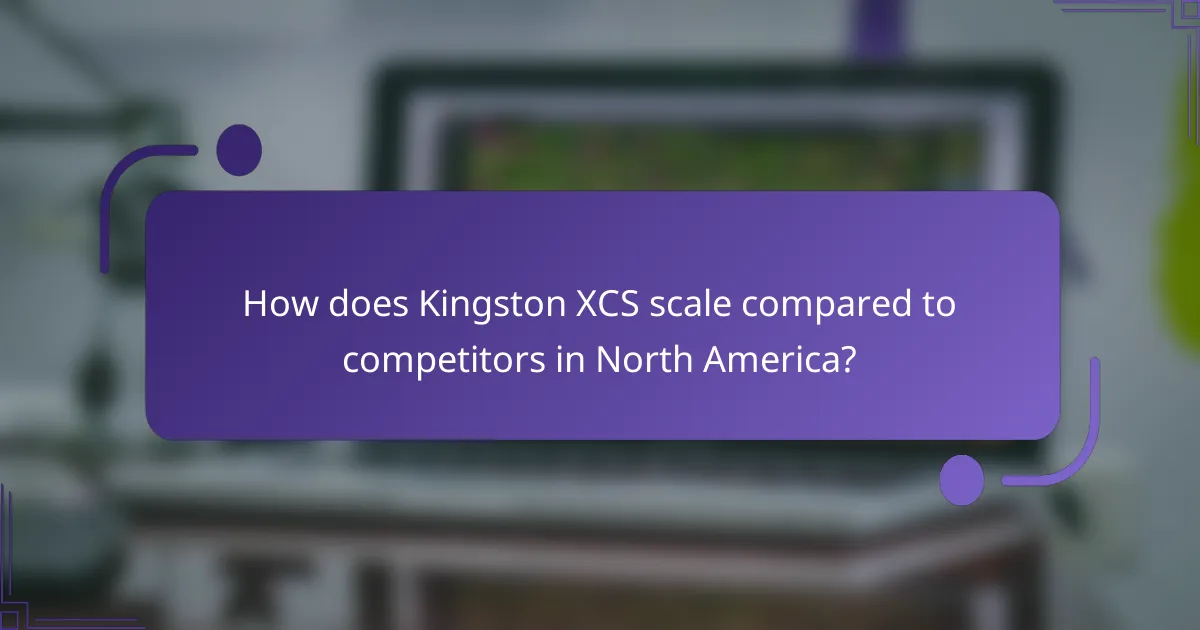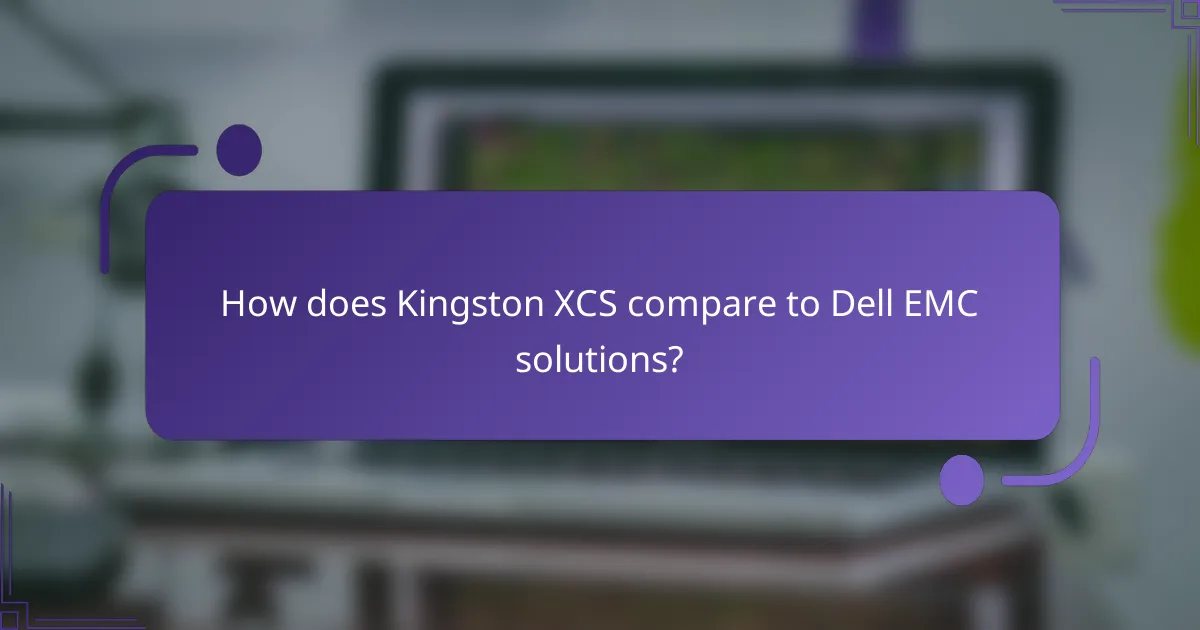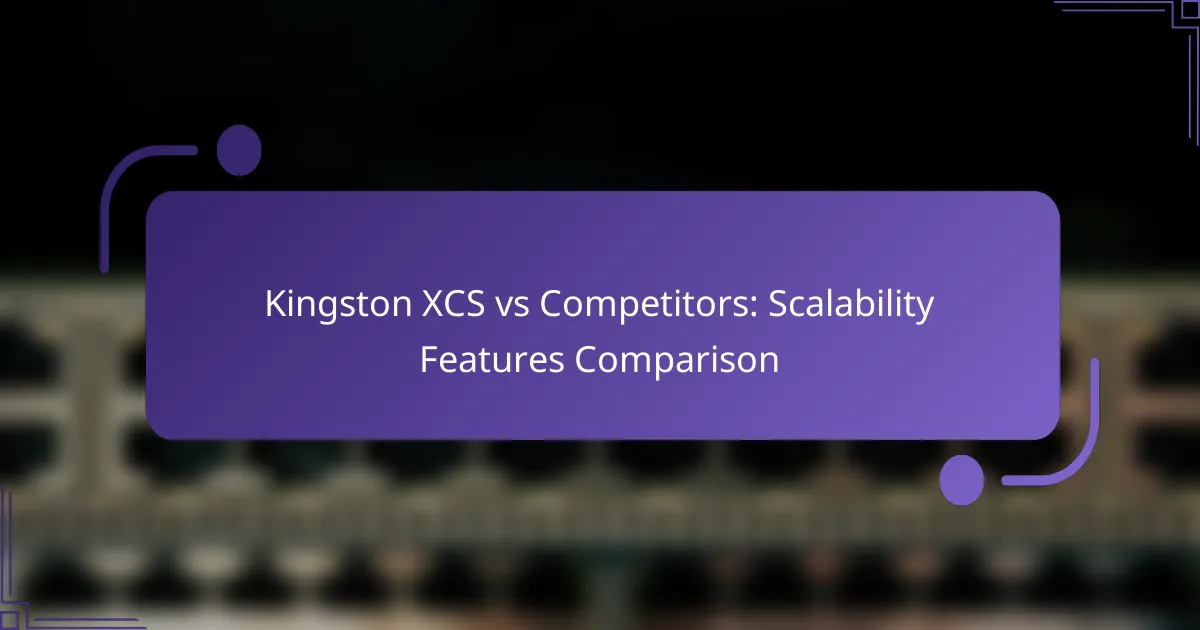Kingston XCS stands out in the market with its advanced scalability features, allowing businesses to effectively manage increasing workloads. Its architecture supports dynamic scaling, multi-tenancy, automated provisioning, and real-time monitoring, ensuring optimal performance and resource utilization compared to competitors. When compared to solutions like Dell EMC, Kingston XCS offers a compelling balance of performance and cost efficiency tailored for diverse operational needs.

How does Kingston XCS scale compared to competitors in North America?
Kingston XCS offers robust scalability features that enable it to efficiently handle increased workloads compared to its competitors in North America. Its architecture is designed to adapt seamlessly to varying demands, ensuring optimal performance and resource utilization.
High performance under load
Kingston XCS maintains high performance even under heavy loads, making it suitable for enterprise-level applications. It utilizes advanced caching techniques and optimized data paths, which can significantly reduce latency and improve throughput during peak usage times.
Competitors may struggle with performance degradation as workloads increase, but Kingston’s architecture is built to sustain consistent performance, often achieving low latency in the low tens of milliseconds range.
Flexible resource allocation
One of the standout features of Kingston XCS is its flexible resource allocation capabilities. Users can dynamically adjust resources based on real-time needs, allowing for efficient scaling without downtime.
This flexibility is crucial for businesses that experience fluctuating workloads, as it enables them to optimize costs and performance. In contrast, some competitors may require manual intervention or longer provisioning times, which can hinder responsiveness.
Integration with cloud services
Kingston XCS supports seamless integration with various cloud services, enhancing its scalability. This allows organizations to leverage cloud resources for additional capacity during peak times or for specific projects without significant overhead.
Many competitors offer cloud integration, but Kingston’s approach is often more streamlined, facilitating quicker deployments and better interoperability with popular platforms like AWS and Azure.
Support for hybrid environments
Kingston XCS is designed to operate effectively in hybrid environments, allowing businesses to combine on-premises and cloud resources. This capability is essential for organizations looking to maximize their existing infrastructure while taking advantage of cloud scalability.
Competitors may not provide the same level of support for hybrid setups, which can lead to challenges in managing resources and data across different environments. Kingston’s solution simplifies this process, ensuring a cohesive operational strategy.
Cost-effectiveness
When considering scalability, Kingston XCS stands out for its cost-effectiveness. Its efficient resource management and performance optimization can lead to lower operational costs over time, especially for businesses with variable workloads.
While initial investments may vary, the long-term savings from reduced downtime and better resource utilization often outweigh the upfront costs. Competitors might offer lower initial pricing but can incur higher costs due to inefficiencies as workloads scale.

What scalability features does Kingston XCS offer?
Kingston XCS provides robust scalability features that enable businesses to efficiently manage growing workloads. Key offerings include dynamic scaling, multi-tenancy support, automated provisioning, and real-time monitoring tools, all designed to enhance operational flexibility and resource optimization.
Dynamic scaling capabilities
Dynamic scaling allows Kingston XCS to adjust resources automatically based on current demand. This means that during peak usage times, additional resources can be allocated seamlessly, while during quieter periods, resources can be scaled back to save costs. This flexibility is crucial for businesses experiencing fluctuating workloads.
For example, an e-commerce platform may need to increase its server capacity during holiday sales, and Kingston XCS can accommodate this need without manual intervention. This capability helps maintain performance and user experience while optimizing resource usage.
Multi-tenancy support
Multi-tenancy support in Kingston XCS enables multiple users or organizations to share the same infrastructure while keeping their data and applications isolated. This feature is particularly beneficial for service providers and enterprises that need to manage various clients or departments within a single environment.
By leveraging multi-tenancy, organizations can reduce costs and improve resource utilization. It allows for more efficient management and scaling of resources, as the infrastructure can be optimized for various workloads simultaneously.
Automated provisioning
Automated provisioning in Kingston XCS streamlines the deployment of resources, allowing users to quickly allocate and configure new instances as needed. This feature minimizes the time and effort required to set up new environments, which is essential for businesses that need to respond rapidly to changing demands.
For instance, a development team can automatically provision test environments for new applications, ensuring that they can work efficiently without waiting for manual setups. This capability enhances agility and accelerates project timelines.
Real-time monitoring tools
Real-time monitoring tools within Kingston XCS provide insights into resource usage, performance metrics, and system health. These tools enable organizations to track their infrastructure in real-time, allowing for proactive management and quick identification of potential issues.
Having access to real-time data helps businesses make informed decisions about scaling and resource allocation. For example, if a sudden spike in traffic is detected, administrators can quickly respond by scaling up resources to maintain service levels, ensuring a smooth user experience.

How does Kingston XCS compare to Dell EMC solutions?
Kingston XCS offers competitive scalability features when compared to Dell EMC solutions, particularly in terms of performance and cost efficiency. Both options cater to businesses looking for robust storage solutions, but they differ in specific capabilities and pricing structures.
Performance benchmarks
In performance benchmarks, Kingston XCS typically demonstrates low latency and high throughput, making it suitable for demanding applications. Dell EMC solutions, while also high-performing, may excel in enterprise environments where advanced features like data deduplication and compression are critical.
For example, Kingston XCS can achieve read and write speeds in the range of several GB/s, while Dell EMC systems may offer similar or slightly higher speeds depending on the configuration. Evaluating your specific workload requirements is essential to determine which solution best meets your needs.
Cost analysis
Cost is a significant factor when comparing Kingston XCS and Dell EMC solutions. Kingston XCS generally provides a more budget-friendly option, especially for small to medium-sized businesses. Pricing for Kingston XCS can range from a few hundred to a few thousand USD, depending on capacity and features.
In contrast, Dell EMC solutions often come at a premium, reflecting their extensive feature set and enterprise-level support. Organizations should consider not only the initial investment but also ongoing maintenance and operational costs when making a decision.
Feature set comparison
The feature sets of Kingston XCS and Dell EMC solutions vary significantly. Kingston XCS focuses on essential scalability and performance features, making it straightforward and user-friendly. Key features include easy integration and management tools that cater to various workloads.
Dell EMC, on the other hand, offers a broader range of advanced features such as automated tiering, extensive data protection options, and analytics capabilities. These features may be more suitable for larger enterprises with complex data management needs. Assessing the specific features that align with your business objectives is crucial for an informed choice.

What are the key differentiators of Kingston XCS?
Kingston XCS stands out in the market due to its unique scalability features, robust security measures, and customizable configurations. These elements allow businesses to efficiently adapt their storage solutions to meet evolving demands while ensuring data protection and flexibility.
Unique scalability architecture
Kingston XCS employs a unique scalability architecture that allows for seamless expansion as storage needs grow. This architecture supports both vertical and horizontal scaling, enabling users to add more resources without significant downtime or disruption.
For example, businesses can start with a modest setup and incrementally increase capacity by integrating additional drives or nodes. This flexibility is crucial for organizations experiencing fluctuating workloads or rapid growth.
Enhanced security features
The enhanced security features of Kingston XCS are designed to protect sensitive data against unauthorized access and breaches. These features include advanced encryption protocols and multi-factor authentication, ensuring that only authorized users can access critical information.
Additionally, Kingston XCS complies with industry standards such as GDPR and HIPAA, making it suitable for organizations that handle sensitive personal or health-related data. Regular security updates further bolster the system’s defenses against emerging threats.
Customizable configurations
Customizable configurations are a significant advantage of Kingston XCS, allowing users to tailor their storage solutions to specific operational needs. This customization can include adjusting performance settings, storage types, and redundancy levels based on the unique requirements of different applications.
For instance, a company focused on high-speed data retrieval might prioritize SSDs, while another requiring extensive archival storage may opt for HDDs. This adaptability ensures that businesses can optimize their investments and achieve the best performance for their workloads.

What are the prerequisites for implementing Kingston XCS?
Implementing Kingston XCS requires specific infrastructure and staff training to ensure optimal performance and scalability. Organizations must assess their current systems and prepare their teams to effectively utilize the platform.
Infrastructure requirements
To successfully implement Kingston XCS, organizations need a robust infrastructure that can handle the software’s demands. This typically includes high-performance servers, adequate storage capacity, and reliable networking equipment. Depending on the scale of deployment, consider investing in redundant systems to enhance reliability.
Additionally, ensure that your infrastructure supports virtualization and cloud integration, as these features are essential for scalability. Regularly updating hardware and software components can help maintain compatibility and performance as your needs evolve.
Staff training needs
Staff training is crucial for maximizing the benefits of Kingston XCS. Employees should be familiar with the platform’s features and functionalities, which may require formal training sessions or workshops. Consider creating a training schedule that includes both initial onboarding and ongoing education to keep skills current.
Encourage team members to engage with available resources, such as documentation and online tutorials. This proactive approach can help prevent common pitfalls and ensure that staff can troubleshoot issues effectively, ultimately leading to a smoother implementation process.
